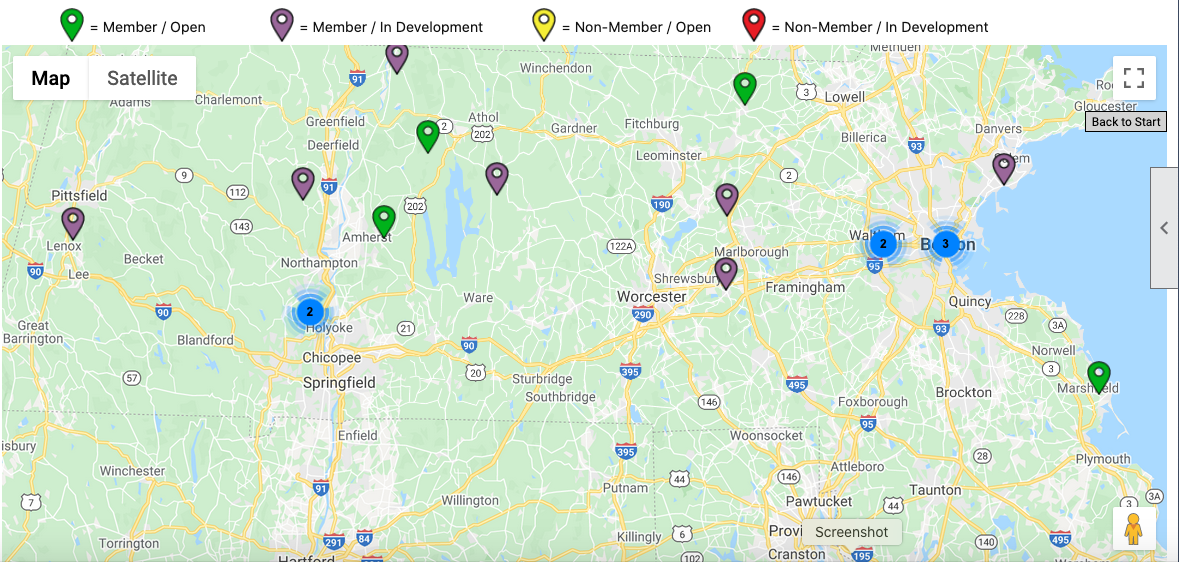The Village Movement
Comes to Central Massachusetts
Villages like Nashoba Neighbors are taking form across the United States to reduce the overall financial and emotional challenges of aging. Currently, there are over 250 Villages and more than 100 in development in 43 states and the District of Columbia. In Massachusetts alone, there are 25 Villages, from Cape Cod to the Berkshires, with 6 more currently in development. Only two Villages currently exist in Central Massachusetts: Groton Neighbors and Nashoba Neighbors, which serves the towns of Berlin, Bolton, and Lancaster.
Click on the map to find Villages in your area!
Support for the Aging Middle Class
The Village Movement is a groundswell response to research and news reports that highlight how the landscape for aging adults is changing. The middle class is becoming poorer, prices are higher, and housing costs are off the charts. While those in the highest income brackets can pay for the services they need and those with the greatest financial need have a range of safety nets and resources provided through government assistance and targeted nonprofit support, those in the middle class are often overlooked. They don’t receive free or low-cost benefits. We have different groups providing services in our towns, but can they do it all?
Did you know:
- In Bolton, 23% of the town’s population is currently age 60 or older and this is projected to rise to 34% by 2030. That’s 1 out of every 3 residents. The town currently allocates less than 1% (0.35%) of its total budget to senior services.
- In Berlin, 30% of the town's population is currently age 60 or older. This is projected to increase to 40% by 2030. The town currently allocates less than 1% of its total budget to senior services.
- In Lancaster, again, 30% of the town population is age 60 or older. By 2030, those over 60 are projected to be 45% of the town's population - imagine, almost one out of every two residents. The town currently allocates just over 1% of the town's services budget to senior services.
None of our towns currently has the infrastructure or budgets to support the projected increase in our senior populations. Given the projected increase in the number of older citizens in our towns, we think those in the aging middle class can use all the help they can get. Nashoba Neighbors is a response to these trends.
An Antidote to Social Isolation
Did you know that research studies have linked loneliness to physical illness and to functional and cognitive decline? “The profound effects of loneliness on health and independence are a critical public health problem,” said Dr. Carla M. Perissinotto, a geriatrician at the University of California, San Francisco. “It is no longer medically or ethically acceptable to ignore older adults who feel lonely and marginalized.”
Social isolation is a big problem for older adults. More older adults are living alone and families often live far away or are too busy to visit often. In a 2011 Robert Wood Johnson Foundation study, 85% of doctors surveyed agreed that unmet social needs directly lead to worsened health outcomes for their patients and agree that social needs are as important to address as medical needs. Only 20% of surveyed doctors felt confident to address these social needs.
The national Village-to-Village Network claims that villages are well positioned to improve the population health of the communities they serve. Village members experience reduced isolation, increased independence, and enhanced purpose of life. Ilene Henshaw, when serving at AARP Department of Governmental Affairs, stated, “Villages are instrumental in helping people remain in their homes and independent in their communities.”
Sources:
Berlin, Boylston, and Lancaster Population Records (Town Clerks’ Offices)
Hafner, Katie (2016). Researchers Confront an Epidemic of Loneliness, New York Times.
Heimlich, Russel (2010). Baby Boomers Retire. FactTank, Pew Research Center.
University of Wisconsin, School of Public Health

